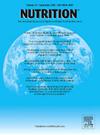Dietary quality, perceived health, and psychological status as key risk factors for newly developed metabolic dysfunction–associated steatotic liver disease in a longitudinal study
IF 3.2
3区 医学
Q2 NUTRITION & DIETETICS
引用次数: 0
Abstract
Objectives
This study investigated biomarkers in individuals with newly developed metabolic dysfunction–associated steatotic liver disease (ND-MASLD) and examined the interplay between genetic predisposition and environmental factors using a machine learning approach in a large longitudinal study.
Methods
Participants were classified into four groups based on metabolic dysfunction–associated steatotic liver disease (MASLD) status between the first and second measurements with an approximate 5-y gap. A model was developed to identify early-stage biomarkers of ND-MASLD (n = 1603). Nutrient intake, dietary patterns, genetic variants, and psychosocial factors were compared among the no MASLD (n = 60 081), recovered MASLD (n = 3181), persistent MASLD (n = 670), and ND-MASLD (n = 1603) groups. Their association with ND-MASLD was also predicted using a machine learning approach.
Results
The model incorporating ND-MASLD status, age, sex, dietary inflammatory index, and metabolic syndrome (MetS), especially low high-density lipoprotein cholesterol and hypertriglyceridemia, at the second measurement demonstrated an optimal fit. High carbohydrate intake with a high glycemic index was associated with elevated ND-MADSLD risk. Fatty liver index was lower in persistent MASLD followed by ND-MASLD, recovered MASLD, and no MASLD. Participants in the ND-MASLD group had lower vitamin D and total isoflavonoid intake and a lower modified healthy eating index, indicating unhealthy diets. The XGBoost and deep neural network models identified age, sex, MetS components, dietary antioxidants, self-rated health, psychological well-being indexes, and serum liver enzyme levels at the second measurement as significant predictors of ND-MASLD. However, polygenic risk scores were not included.
Conclusions
Early-stage biomarkers of ND-MASLD were closely linked to MetS incidence. Dietary quality, perceived health status, and psychological stress emerged as potential targets for MASLD prevention strategies, with lifestyle modifications potentially overriding genetic predispositions. The results indicate that preventive strategies about lifestyle modification should be developed for MASLD.
在一项纵向研究中,饮食质量、健康感知和心理状态是新发代谢功能障碍相关性脂肪肝的关键风险因素。
研究目的本研究调查了新发代谢功能障碍相关性脂肪性肝病(ND-MASLD)患者的生物标志物,并在一项大型纵向研究中使用机器学习方法研究了遗传易感性与环境因素之间的相互作用:根据第一次和第二次测量之间的代谢功能障碍相关性脂肪性肝病(MASLD)状况,将参与者分为四组,间隔时间约为5年。建立了一个模型来确定ND-MASLD的早期生物标志物(n = 1603)。在无MASLD组(n = 60 081)、MASLD恢复组(n = 3181)、MASLD持续组(n = 670)和ND-MASLD组(n = 1603)之间比较了营养摄入、饮食模式、遗传变异和社会心理因素。他们与ND-MASLD的关联也通过机器学习方法进行了预测:结果:结合 ND-MASLD 状态、年龄、性别、膳食炎症指数和代谢综合征(MetS),尤其是第二次测量时的低高密度脂蛋白胆固醇和高甘油三酯血症的模型显示出最佳拟合效果。高血糖指数的高碳水化合物摄入量与 ND-MADSLD 风险升高有关。脂肪肝指数在持续性MASLD中较低,其次是ND-MASLD、恢复期MASLD和无MASLD。ND-MASLD组的参与者维生素D和总异黄酮摄入量较低,改良健康饮食指数较低,表明饮食不健康。XGBoost和深度神经网络模型发现,年龄、性别、MetS成分、膳食抗氧化剂、自评健康、心理健康指数以及第二次测量时的血清肝酶水平是ND-MASLD的重要预测因素。结论:ND-MASLD的早期生物标志物对其预测具有重要意义:结论:ND-MASLD的早期生物标志物与MetS发病率密切相关。膳食质量、健康状况感知和心理压力成为MASLD预防策略的潜在目标,生活方式的改变有可能超越遗传倾向。研究结果表明,应针对MASLD制定有关改变生活方式的预防策略。
本文章由计算机程序翻译,如有差异,请以英文原文为准。
求助全文
约1分钟内获得全文
求助全文
来源期刊

Nutrition
医学-营养学
CiteScore
7.80
自引率
2.30%
发文量
300
审稿时长
60 days
期刊介绍:
Nutrition has an open access mirror journal Nutrition: X, sharing the same aims and scope, editorial team, submission system and rigorous peer review.
Founded by Michael M. Meguid in the early 1980''s, Nutrition presents advances in nutrition research and science, informs its readers on new and advancing technologies and data in clinical nutrition practice, encourages the application of outcomes research and meta-analyses to problems in patient-related nutrition; and seeks to help clarify and set the research, policy and practice agenda for nutrition science to enhance human well-being in the years ahead.
 求助内容:
求助内容: 应助结果提醒方式:
应助结果提醒方式:


